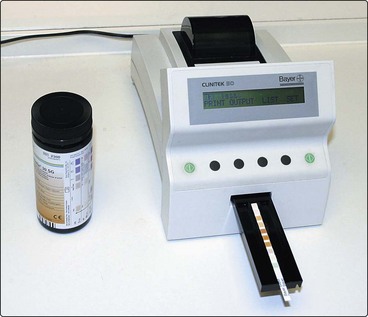4 Table 4.1 shows what can be commonly measured in a blood sample outside the normal laboratory setting. The most common blood test outside the laboratory is the determination of glucose concentration, in a finger stab sample, at home or in the clinic. Diabetic patients who need to monitor their blood glucose on a regular basis can do so at home or at work using one of many commercially available pocket-sized instruments. Table 4.1 Common tests on blood performed away from the laboratory Figure 4.1 shows a portable bench analyser. These analysers may be used to monitor various analytes in blood and urine and are often used in outpatient clinics. Table 4.2 lists urine constituents that can be commonly measured away from the laboratory. Many are conveniently measured, semi-quantitatively, using test strips which are dipped briefly into a fresh urine sample. Any excess urine is removed, and the result assessed after a specified time by comparing a colour change with a code on the side of the test strip container. The information obtained from such tests is of variable value to the tester, whether patient or clinician. Table 4.2 Tests on urine performed away from the laboratory
Point of care testing
Outside the laboratory
Analyte
Used when investigating
Blood gases
Acid–base status
Glucose
Diabetes mellitus
Urea
Renal disease
Creatinine
Renal disease
Bilirubin
Neonatal jaundice
Therapeutic drugs
Compliance or toxicity
Salicylate
Detection of poisoning
Paracetamol
Detection of poisoning
Cholesterol
Coronary heart disease risk
Alcohol
Fitness to drive/confusion, coma
Analyte
Used when investigating
Ketones
Diabetic ketoacidosis
Protein
Renal disease
Red cells/haemoglobin
![]()
Stay updated, free articles. Join our Telegram channel

Full access? Get Clinical Tree

 Get Clinical Tree app for offline access
Get Clinical Tree app for offline access

